Following on from my trip to the Farne Islands, we made a stop off at the RSPB reserve, Bempton Cliffs to check out the gannets. Going against everything you’d expect to want, the weather was cloudy and windy, but that was perfect for capturing images of these magnificent birds as they gathered nesting material from the cliff tops.
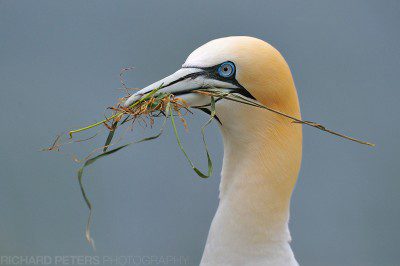
Gannet with nesting material. D3s, 600 VR, ISO 1800
Much like the Farne Islands, the sheer amount of birds viewable, along with the sound they make, is incredible. I could quite literally sit and watch them fly about all day. I filmed a brief 45 second video to show the sweeping view from one of the viewing platforms. It starts off viewing the gannets landing on the cliff top (from the reverse side of where the below images were taken) then sweeps round to show the sheer scale of the cliff faces along with an idea of how many birds you can expect to see there.
Hopefully it also gives you an idea of the weather conditions of the day and generally helps to set the mood for the following blog post.
WHAT ARE BEMPTON CLIFFS?
An RSPB reserve near Bridlington in East Yorkshire, the chalk cliff faces of Bempton are home to over 200,000 seabirds during the peak season between April and August. The main attraction being the incredible gannets, although other species from puffins to kittiwake to short eared owl (in the autumn) can be found here.
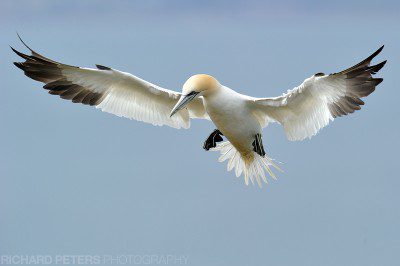
The wind helped slow the gannets down.
Opening times: Always open, but visitor centre hours are, March to October: 10am – 5pm. And November to February: 10am to 4pm
Entry fee: Free to RSPB members, £3.50 per car to non-members
More info: Check out the RSPB website
JUST THE GANNETS PLEASE
My stop off at Bempton with fellow photographer Austin Thomas, came as an offshoot to our Farne Island trip, and seemed a logical location to visit on our way back down the country from Northumberland. We arrived on the Friday afternoon and after walking out to the cliffs from the car park, we were greeted with the initial concern that the grasses along the cliff edge were too high, meaning we couldn’t photograph the birds very easily as they flew up to perch on the cliff tops. After checking out a couple of the viewing points and see the various species to be found there nesting on the cliff faces, we decided we were determined to get some action shots, and not static, nesting birds – and given we had seen so many of the other species the last two days, we knew we wanted one thing, and one thing only. Gannets.
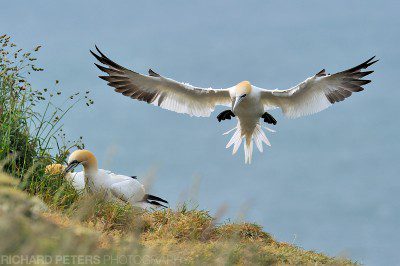
A gannet lands to join the others gathering grass
We wondered back along the path a little more and found the perfect spot, were the gannets would fly up and perch on the top of the cliff, gather a beak full of nesting material then fly off back to their nest. As mentioned previously the grass was far too long, but we scouted out a location back down the path which looked back towards this prime landing spot. Thankfully, between our 600 & 800mm lenses we were still able to get the action in frame, despite being a little way back.
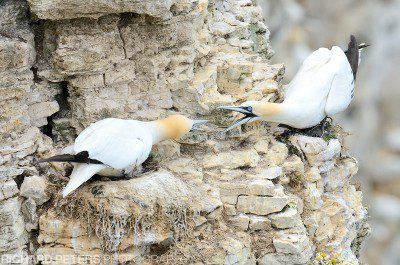
Nesting gannets on the cliff face. D7000, 600 VR
Although the weather was mostly very overcast, resulting in slightly less vibrant images initially, this came with the advantage of making it easier to photograph these large white birds without blowing the highlights too much in their feathers. Blowing feather detail is very easy when the sun is too harsh and so we were quite thankful for the cloud cover. The wind also played to our advantage as it slowed the gannets down as they approached the cliff tops, enabling us to capture some nice poses as they came in to land. Although almost all of my images were caught from one angle, I did briefly position myself in a different spot which Austin had worked out would get a head on shot if we were patient. From this second position we could not see the gannets at all unless one flew up higher than the flight path they were typically using. But on the rare occasion they did, they would be coming straight towards camera, and the out of focus grass and flowers would make for a nice frame, as the gannet flew towards them to gather it’s haul.
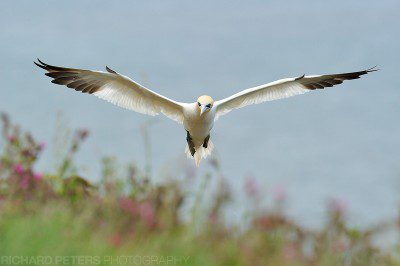
Target in sight, a gannet heads towards the foreground grass
We spent several hours at Bempton, but had to call it a day early evening as both Austin and I had 4 hours worth of driving each to get back to our respective homes. I did enjoy the afternoon we spent photographing the gannets though, and look forward to a repeat visit in the future.








